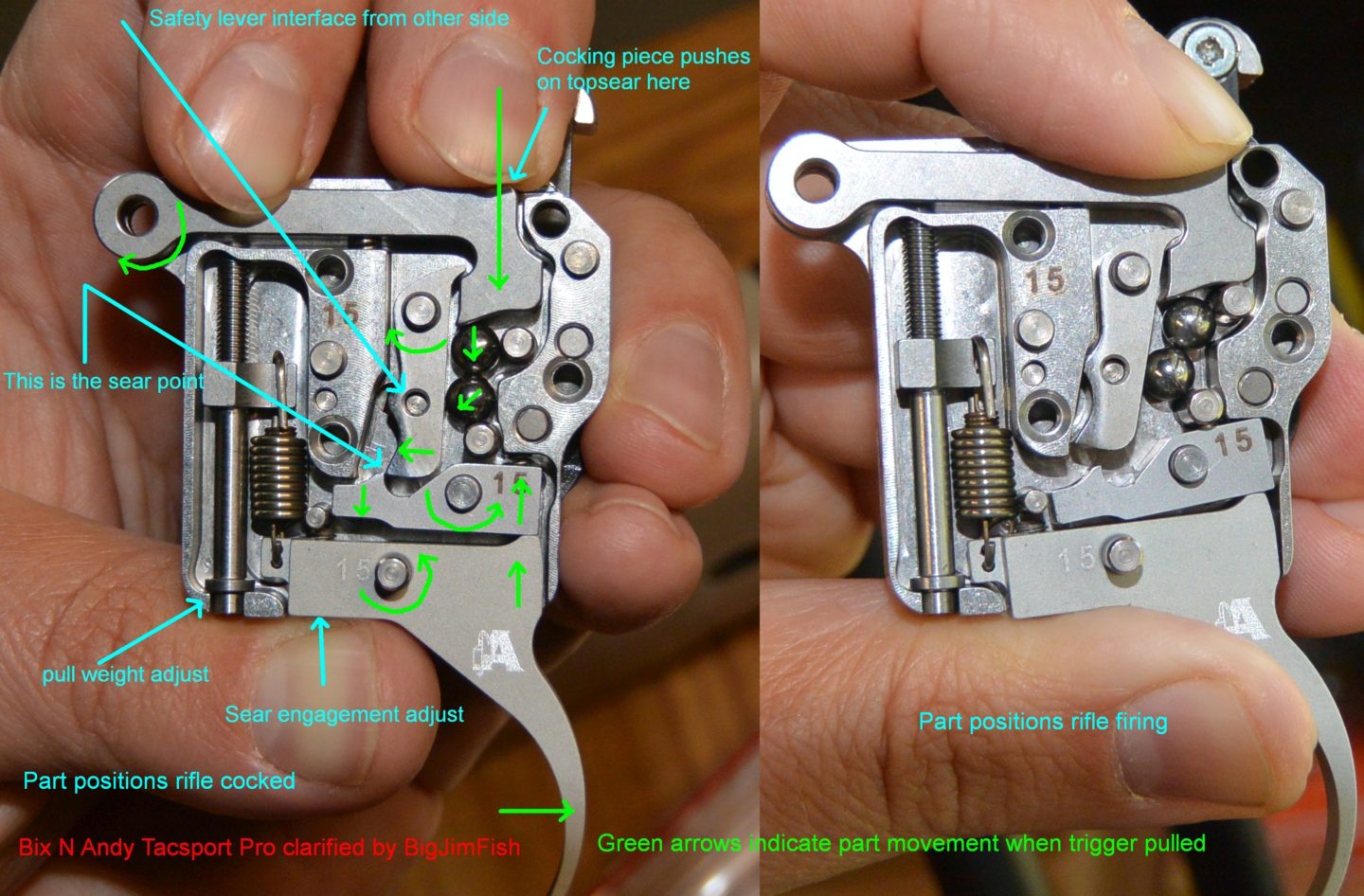
Bix’n Andy single stage TacSport left and two stage TacSport pro right.
Initially, this was intended to be a sub-section of the Kelbly Atlas Tactical custom rifle review. However, I became more interested in the intricacies of the ball trigger concept, and the text kept growing. It is now to the point that this is clearly a review on its own and not a sub-section of another. Normally, I really don’t spend much time thinking about triggers. It is not that they don’t matter. They certainly do. It is just that a lot of companies make triggers that work well enough, or, at least I thought that was the case until recently. I couldn’t escape talk of this Austrian made Bix’n Andy trigger with balls. I kept hearing that it didn’t just work differently but actually WORKED differently (you can figure that one out). The last straw was when I saw that Kelbly’s had decided to make Bix’n Andy the standard trigger on all their rifles. This made a particular impression on me since not that long ago, Kelbly’s had actually manufactured high performing, exceptionally low pull weight triggers themselves. I had the card of the Bix’n Andy importer Bullet Central from some year at SHOT Show, so I gave them a call and they told me they had a new TacSport Pro model coming that they were interested in me trying out. The TacSport Pro lowered the weight of the TacSport from a 10oz – 4.5lbs range to a 3.5oz – 2.2lbs range. This was in response to some of the PRS guys wanting a lighter pull weight but not wanting to use the benchrest model because those are too susceptible to dusty conditions. Throughout the review I was able to test a total of four different Bix’n Andy triggers, which included a TacSport, the TacSport Pro in both single stage and two stage configurations, and a prototype TacSport Pro that featured a little different spring configuration. The differences between these, aside from the single stage and two stage characteristics, come down to the Pros featuring a little more honing on the sear surfaces and a different spring set.
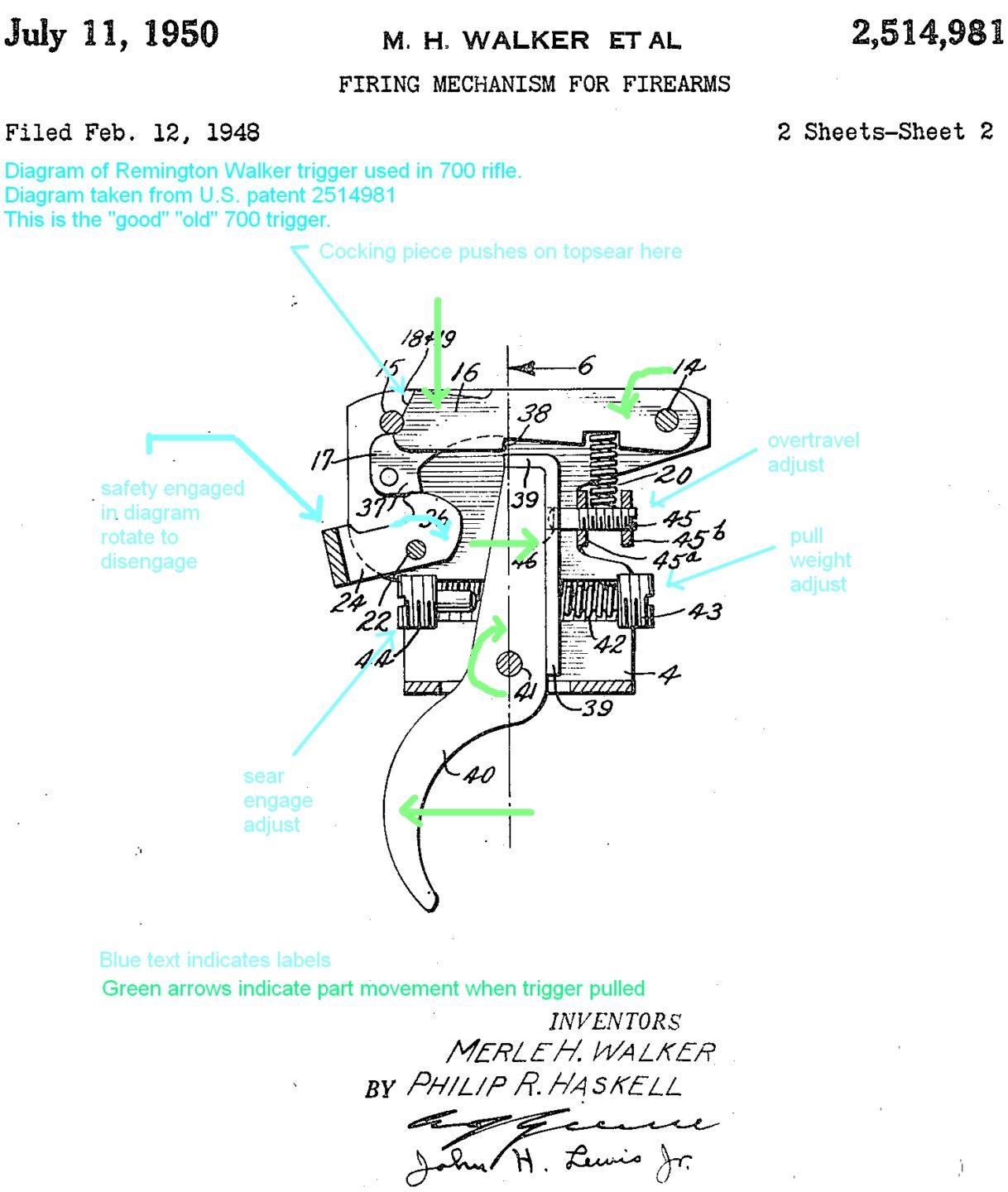
Background on Trigger Design Concepts
Most triggers are very simple; having one sear edge on the trigger and the other on the topsear that interfaces with the cocking piece in the rifle. The Walker diagram above is a good example of this simple design and one of the best loved executions of such. More expensive, lighter pull weight, and more complex triggers tend to add more moving parts and levers to this. The added parts tend to add greater adjustment, lower the weight on the sear surface, lower sear engagement, and also lower pull force. Things get more precise, more expensive, and, usually, more prone to fail when dirty. One great problem encountered in the design of these complex triggers is that taking more weight off the sear means that it must go somewhere else. This often adds weight, and therefore friction, to key pivot points, which can result in things not feeling so smooth. It can also result in partially pulled triggers not resetting to full sear engagement and a high necessary reset force on the topsear which slows the lock time and causes drag between the firing pin and bolt body. Bix’n Andy’s big idea is to get around using a pin that rotates under great force by having two ball bearings bear the force at this key place in the trigger design. The idea is that the ball bearings can move with less friction than a pin could, allowing your trigger to be smoother, more consistent, and have a lower topsear force. They tried to explain this in their product literature, but I didn’t really get exactly how it worked until I took the thing apart, analyzed it, and compared it to other designs. Below is a labeled picture of a loaded Bix’n Andy with green arrows to show the direction parts move when fired and blue arrows for labels. It is worth noting that Bix’n Andy triggers are very easy to disassemble and doing so does not void the warranty. This allows for cleaning, degreasing should a bit of lube sneak down from the action, switching of the trigger shoe with one of several options you can purchase in the variety of styles you might expect, or changing out the topsear if your aftermarket action is one of those with a cocking piece not made to true clone specs.
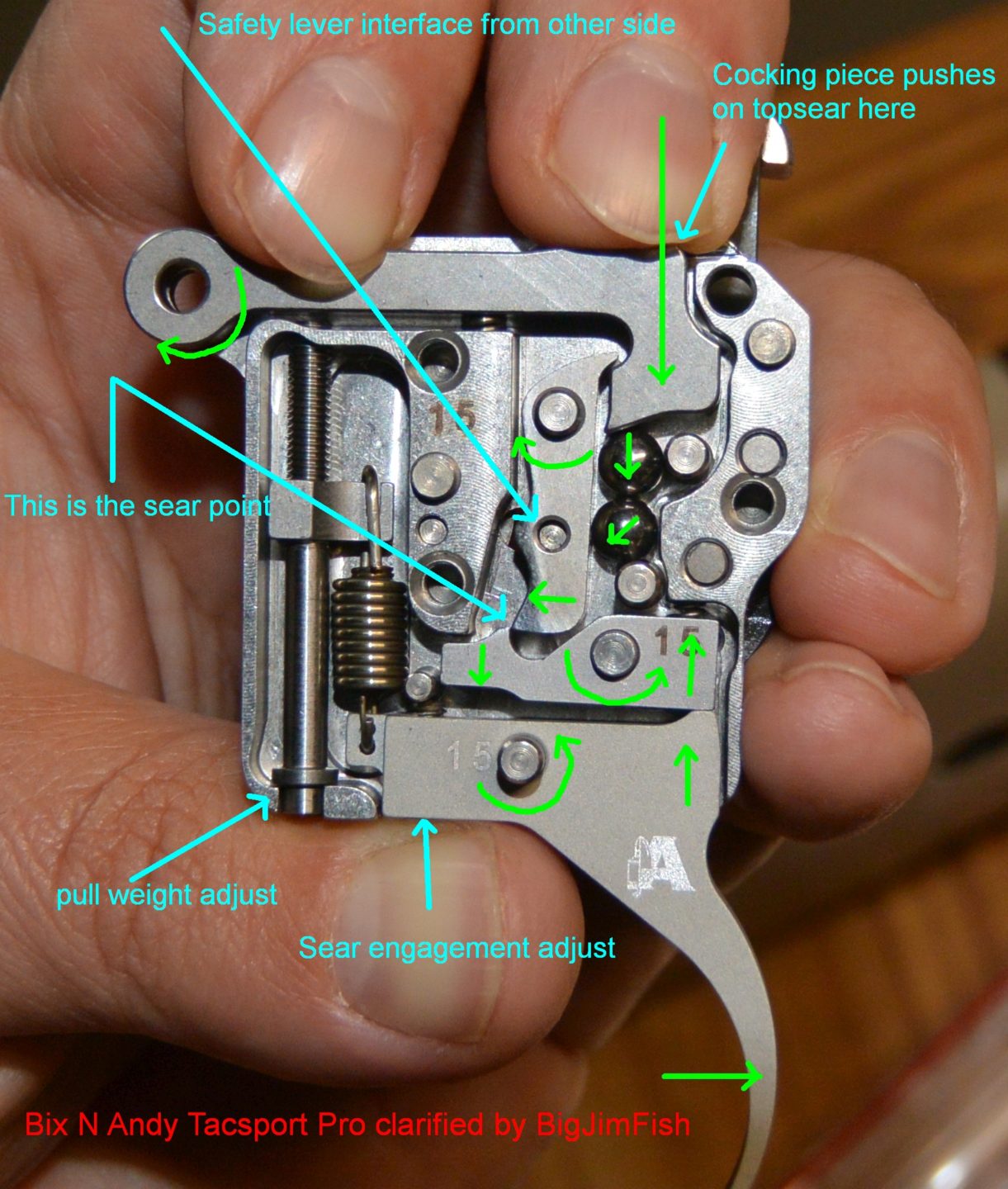
Pull Weight Testing
The guys at Bullet Central were nice enough to loan me a set of high precision Haag-Streit Correx force gauges so I was able to test trigger pull weight with a very high degree of accuracy. (Common pull gauges, such as the Lyman digital one, do not have the accuracy necessary to conclude much.) Through this testing, I was able to determine that the basic ball concept of a Bix’n Andy trigger appears to work. I say ‘appears’ because the Bix’n Andy does indeed display almost no pull-to-pull variation in weights aside from that which can be isolated as originating in the pull weight adjust spring. This will be noted in the results at minimum weight, at which point the main pull weight adjust spring is not engaged. The Bix’n Andy is also a magnificently precisely machined unit and no doubt gains some of its consistency from higher manufacturing standards rather than conceptual superiority.
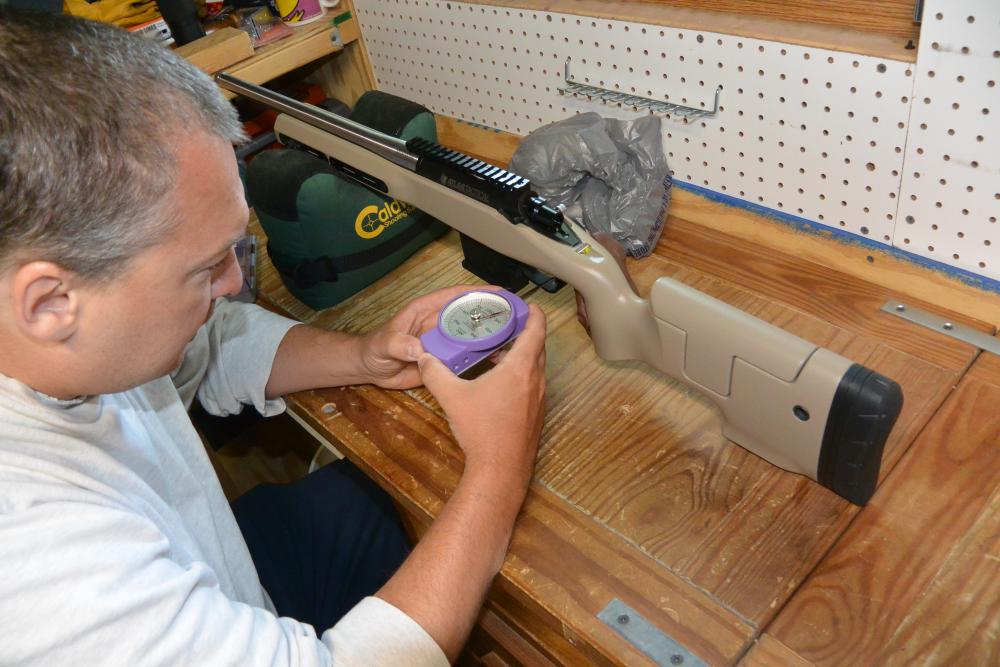
In order to produce the table of trigger pull data below, I borrowed just about every rifle I could get my hands on. It should be noted that many of the triggers involved are not in as unmolested a condition as the Bix’n Andys and TriggerTechs are, but rather have been hand-honed to improve performance. Similarly, the Bix’n Andys and TriggerTechs are run dry (this is recommended.) I do not live in the dusty southwest, but in lush Ohio, and most other triggers are lubed. This makes the performance of the Bix’n Andy products all the more impressive and is a big reliability advantage for the Bix’n Andy and TriggerTech products, as both are made to be run dry and are therefore more resistant to dirt. Whenever possible, I tested the 700 footprint triggers in a Kelbly Atlas Tactical action for consistency.
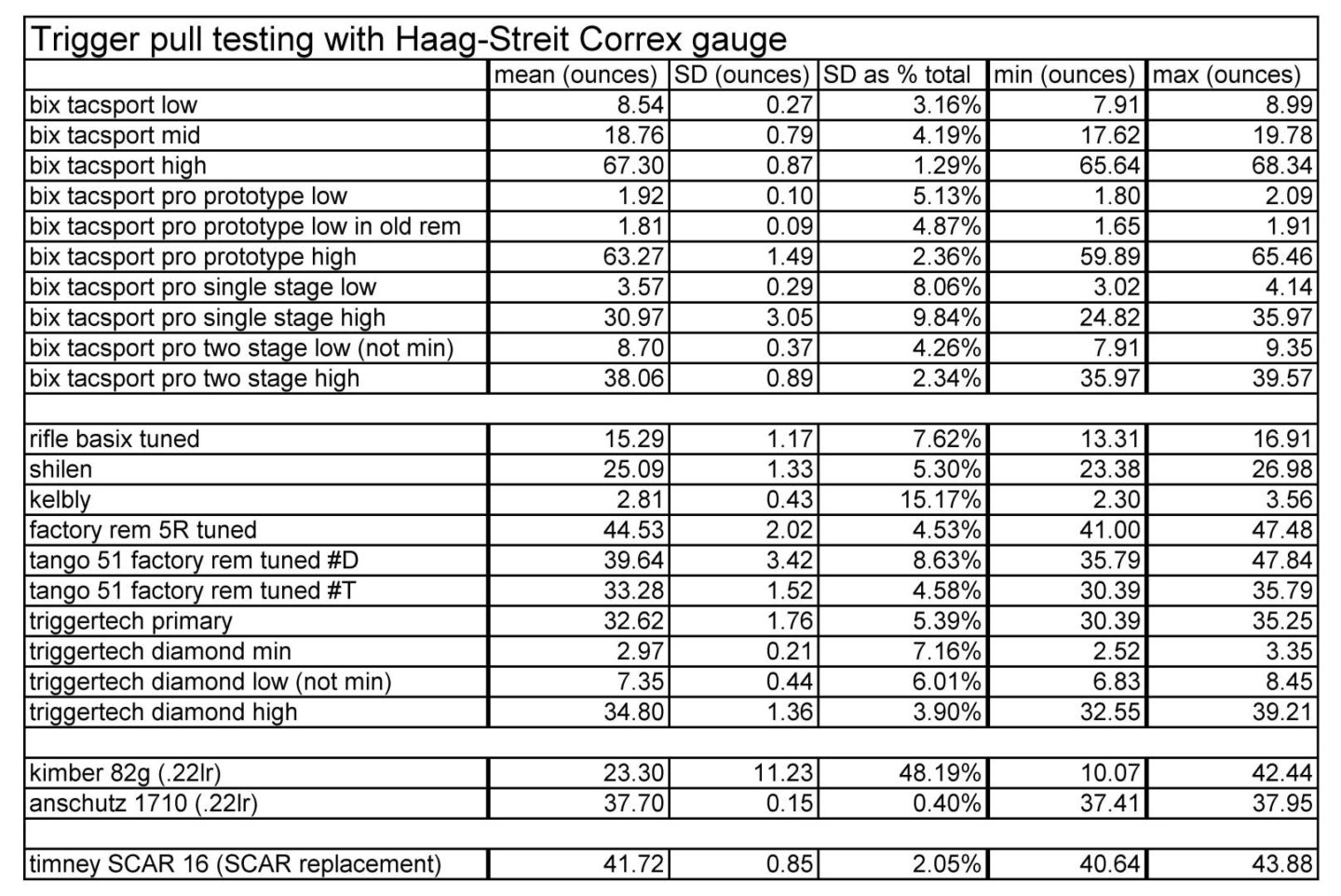
Three of the four Bix’n Andy triggers tested consistently performed with less pull-to-pull variation in weights than all other similar pull weight Remington 700 footprint triggers as well as most of the other triggers. The only big exception to this trend was a high performing Anschutz .22lr trigger which was significantly more consistent at weight. Interestingly, that Anschutz, which is not their legendary 5018 trigger, has massive creep and is easily the worst feeling trigger in the bunch. In practice, the variations in pull weight from pull-to-pull on many of the triggers tested were well within the range at which I could easily note the force difference when testing even before looking at the gauge. That transition between being able to notice pull-to-pull variation seems to occur somewhere around the standard deviation of 5% range at 2lbs, but is more like 10% when down at 8oz. This pull force consistency matters, therefore, as it can result in a shot not breaking at the point the shooter expects. This is bad in all cases, but becomes more so the less stable the shooting position is.
The fourth Bix’n Andy tested, the TacSport Pro single stage, was simply not up to the standards of the other three. It felt a little gritty in hand when I first actuated it and this difference in feel was immediately born out by the gauges when I tested it. It did not have as high degree of pull to pull break weight consistency as the others. I took the trigger apart to investigate. It was a bit harder to take apart than the others and I found very slight drag marks where the sear was touching the case when the trigger was actuated. I believe that the pin the sear pivots on is not exactly straight in the case. The result of this is a functional, safe, trigger that is just not quite as good as the others. This trigger does not meet the standards of either the Bix’n Andy or Bullet Central guys, should not have shipped, and would be replaced in the event that another such example were to make it to a customer.
Other Bix’n Andy Features
Beyond the shot-to-shot consistency, the Bix’n Andy TacSport line has a few other advantages. The first of these is the absolutely massive adjustment range. The TacSport adjusts from 10oz – 4.5lbs and the TacSport Pro goes from 3.5oz – 2.2lbs. Those are huge ranges, adjustment is all done without disassembly or spring swapping and, as with all adjustment, can be done with the action still in the stock. This range gives you the ability to load test your rifle at the range with the lightest of pulls and then to hunt in cold weather, with gloves, at a hearty 4.5lbs. Because of the design, changing that weight also does not appear to change the force on the sear, so you will not have to carefully readjust this with different pull weights as is customary. With hunting in mind, the TacSport has a unique safety lever that has a little detent on it such that to flick the safety off accidentally is a little harder than normal. The lever has to be pushed just a little out before you can rotate it forward. These triggers are also designed to run dry so that you will have far fewer problems picking up dust and grime in the mechanism and clogging it up. The case design has a few other anti dirt features as well to keep dirt out and direct any that gets in away from the most crucial points. In the unique Bix’n Andy design, the two stage TacSports have no sear movement during the first stage, which means they will not get stuck in an unsafe condition with less than full sear engagement if the trigger is let off without firing after the first stage is pulled. Lastly, I should note that the Bix’n Andy triggers are very precise. Because of this, some custom 700 footprint actions (not the Kelbly), that do not have cocking pieces to original specs, will require a non-standard topsear. Be sure to inquire about the compatibility of your particular action with the guys at Bullet Central when you order your trigger.
Summary
The Bix’n Andy TacSport line, though their most affordable line, is nevertheless one of the more expensive trigger options for the 700 platform. They start at $235 for the single stage TacSport and go up to $295 for the two stage TacSport Pro. Though the TacSports I tested certainly excelled in the pull weight variance testing I did, they did even better in the field testing. I have never used anything that has felt better and this sentiment is widely shared. I also appreciate the feature set. The large pull weight adjustment range, extra safety detent, and fully independent two stages. Despite the low minimum pull weight I was also unable to slam fire or otherwise coax an AD from the trigger. In short, I am very impressed with the Bix’n Andy TacSport triggers and a good deal less satisfied with many of my other triggers than I was before this review. Those old Walker triggers, tuned as they might be, are on their way out. If you have interest in any of these Bix’n Andy TacSport triggers, keep your eyes pealed on BulletCental.com for their upcoming promo pricing on the line as well as a free alternate trigger shoe style with purchase of any TacSport or TacSport Pro.
